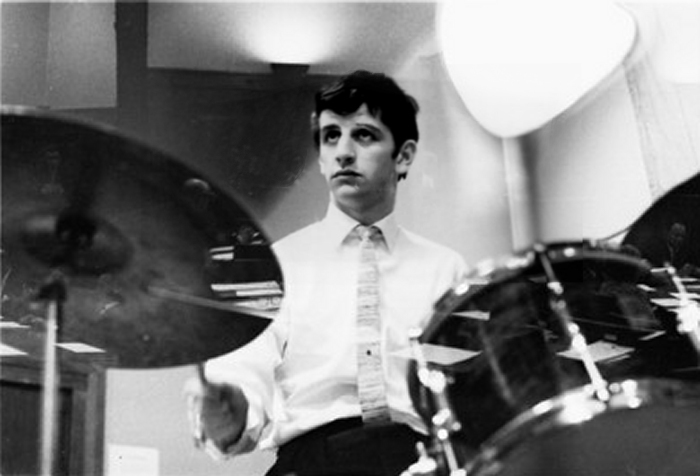

Learning Ringo’s Drum Parts
Phil Kelly has been playing drums for the best part of his life, including playing in Beatles tribute bands and learning to play like Ringo. It don’t come easy!
Forty plus years later Phil has never looked back, playing with a number of Boston and local based ‘60s/’70s bands such as The Jammers, Sherman and the Waybacks, Mr. Peabody and Beatle tribute bands such as Instant Karma, BeatleTracks, and Glass Onion.

“Seemingly, all of that became clear when the camera zoomed in above John, Paul and George in the middle of ‘I Want To Hold Your Hand’. I was immediately awestruck by how easily Ringo swayed to the music behind his Ludwig Black Oyster Pearl kit. So, without even knowing his impact on the world, Ringo has inspired millions of kids just like me to pick up a set of stick and emulate every little nuisance of his playing.”
A Lefty on a Righty
Like many drummers, attempting to emulate Ringo wasn’t as easy as it appeared. “The problem is Ringo is a left handed drummer playing a right handed kit,” said Phil, “and as a result his drum fills are counter-intuitive and difficult to reproduce exactly.”
Kelly explained what it is like, as a drummer, and especially one who has played in a Beatles tribute band, to recreate Ringo’s drum patterns. “When a right handed drummer like myself does a drum fill around the kit, we lead with our right hand. Ringo, being a left handed drummer, leads with his dominant left hand. The end result of this unorthodox style of drumming produces a different sound because of the crossing of the left hand over the right. This nuisance is inherently Ringo’s playing style and ironically, it is what makes his drumming style challenging.
Tell Me Why
“A practical example of this uniqueness can be found when Ringo plays the opening measures to ‘Tell Me Why’. He leads with his left hand in the tumbling drum fill off the tom and snare. Later in that song, Ringo plays a measure of triplets (again leading with his left hand) that leads nicely into the final refrain and the tumbling drum fills to end the tune. The same can be said for Ringo’s drumming on ‘I Want To Hold Your Hand’. In this song, Ringo attacks the snare and tom with powerful accents, again leading with his left hand that complements the phrasing by John and Paul on the song’s title.
The Swish
“Another nuisance that was revolutionary and a very much a part of the early Beatle recording (and one that I learned early in my Beatle tribute band days) was to play the hi-hat in a slightly opened position, playing the time sequence (usually in quarter notes) in a figure eight pattern. When Ringo played this unique style, it produced a totally different sonic than playing straight up and down quarter notes. The end result is a rhythmic pattern that gives the song a swing feel and because of the slightly open positioning of the hi-hats, creates a sizzle or swishing sound. Ostensibly, Ringo’s style of hi-hat play turned the hi-hat into what sounds like a ride cymbal. Evidence of this style of hi-hat playing can best be found in ‘I Want To Hold Your Hand’, ‘Please Please Me’ and ‘All My Loving’.
Ringo’s Feel For The Song
“Ringo’s drumming is not overly technical but the strength of his drumming is his feel for the song. There are hundreds of technically superb drummers that are adept at sight reading from charts, but few have the feel for a song that Ringo possesses. Jim Keltner, the great studio drummer and long-time admirer of Ringo’s playing, said; ‘everything Ringo played had such great, deep natural feel. He’s a song drummer. Guys that sit down and they hear the song and they play appropriately for that song.’
The Relaxed Swing
“Anyone can learn how to play quarter, eights and sixteenth notes but having a feel for a song is a very special skill. I realized early on in my playing career that to accurately reproduce Ringo’s drumming style, I needed to master the use of my left hand in accentuating my fills around the kit, while focusing on that relaxed swing he brought to every note. The challenge for myself, even today, is to allow that feel to come through without rushing the tempo.
“One of the things that always amazed me about Ringo’s drumming is his ability to reproduce a nearly flawless tempo take after take. His drumming is always spot on; he never overplayed his part, and always provided exactly what the song needed. As a young drummer learning the craft, I try to model these tenets of playing into my own style.
No Beatles without Ringo
Ringo, for me, and I’m sure many others influenced by him, is the reference point used as to what a great drummer is and should be. I’ve always argued with my musical colleagues that the Beatles don’t become the Beatles without Ringo’s unique style of drumming.”
Discover more about Ringo and why he is rightly considered one of the all-time greatest drummers in Finding the Fourth Beatle.

Finding the Fourth Beatle – Double CD
This double CD has 41 tracks by 17 different drummers who all played with The Beatles




















